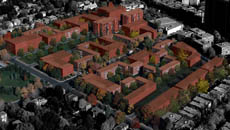Benny Farm : managing complexity
by Jacques Lachapelle
, published 2007-05-01

Destined to accommodate veterans, Benny farm has recently avoided demolition in order to become, for one, a sustainable development project internationally recognised thanks to the Holcim Foundation award presented to l'ŒUF.
Such a journey did not happen without rough patches. It comprises several stages with one of them resembling a competition: the definition of the master plan. It is questionable whether or not it is really a competition. Like a conventional ideas competition, four agencies did present master plans. But there was no jury per say. Previously, a Task Force formed of residents of Benny Farm as well as the neighbourhood, elaborated objectives. The architects were present during those meetings. The submitted projects were discussed by the Task Force and presented to the public for comments. The firm Saïa, Barbarese, Topouzanov Architectes was appointed by the CLC, principal developer, but their master plan continuously evolved and part of its completion was allotted to l'OEUF.
In view of all the uncertainties known by the project, a competition became a way of channelling ideas and making them progress. In comparison with the typical competition aiming at an original solution, what becomes of the purpose of a competition in an open planning and participative process? In this situation, the competition reveals itself to be a means of a closer monitoring of the process. There is no place here for authoritarianism to the benefit of attentive listening. Considering the energies needed, such a competition seems only to justify itself in cases of great social complexities where contributors are more than simple consumers but full users and citizens.
Be that as it may, Benny farm can certainly be placed in Montreal's great experiences on social projects, like Milton Park for instance. But on another level, it raises the question of social housing in contemporary architecture as well as the relevance of competition in regards to this issue. With this consideration, the L.E.A.P. gets involved via the competition launched by Anne Cormier approaching the students of the Canadian architecture schools for which the second part will start this summer.
Such a journey did not happen without rough patches. It comprises several stages with one of them resembling a competition: the definition of the master plan. It is questionable whether or not it is really a competition. Like a conventional ideas competition, four agencies did present master plans. But there was no jury per say. Previously, a Task Force formed of residents of Benny Farm as well as the neighbourhood, elaborated objectives. The architects were present during those meetings. The submitted projects were discussed by the Task Force and presented to the public for comments. The firm Saïa, Barbarese, Topouzanov Architectes was appointed by the CLC, principal developer, but their master plan continuously evolved and part of its completion was allotted to l'OEUF.
In view of all the uncertainties known by the project, a competition became a way of channelling ideas and making them progress. In comparison with the typical competition aiming at an original solution, what becomes of the purpose of a competition in an open planning and participative process? In this situation, the competition reveals itself to be a means of a closer monitoring of the process. There is no place here for authoritarianism to the benefit of attentive listening. Considering the energies needed, such a competition seems only to justify itself in cases of great social complexities where contributors are more than simple consumers but full users and citizens.
Be that as it may, Benny farm can certainly be placed in Montreal's great experiences on social projects, like Milton Park for instance. But on another level, it raises the question of social housing in contemporary architecture as well as the relevance of competition in regards to this issue. With this consideration, the L.E.A.P. gets involved via the competition launched by Anne Cormier approaching the students of the Canadian architecture schools for which the second part will start this summer.













